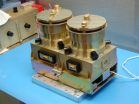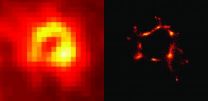(Press-News.org) On a cold February night in Poker Flat, Alaska, a team of scientists will wait patiently for the exotic red and green glow of an aurora to illuminate the sky. Instead of simply admiring the view, this group from NASA's Goddard Space Flight Center of Greenbelt, Md., and The Aerospace Corporation of El Segundo, Calif. will launch a sounding rocket up through the Northern Lights. The rocket could launch as early as the night of Feb. 2, 2013, but the team has a two-week window in order to find the perfect launch conditions.
Armed with a series of instruments developed specifically for this mission, the VISIONS (VISualizing Ion Outflow via Neutral atom imaging during a Substorm) rocket will soar high through the arctic sky to study the auroral wind, which is a strong but intermittent stream of oxygen atoms from Earth's atmosphere into outer space. Although the rocket will survive only fifteen minutes before splashing down in the Arctic Ocean, the information it obtains will provide answers to some long-standing questions, says Doug Rowland, who is the VISIONS principal investigator at Goddard.
VISIONS will study how oxygen atoms leave Earth's atmosphere under the influence of the aurora. Most of the atmosphere is bound by Earth's gravity, but a small portion of it gets heated enough by the aurora that it can break free, flowing outwards until it reaches near-Earth space. The atoms that form this wind initially travel at about 300 miles per hour -- only one percent of the speed needed to overcome gravity and leave Earth's atmosphere.
"This oxygen would normally never gain enough energy to leave the atmosphere," says Rowland. "On the other hand, at very high altitudes, satellite experiments have measured oxygen atoms moving faster than 50 miles per second. These experiments have shown that if oxygen can reach these high altitudes, there are plenty of ways for it to gain even more energy, in which case the oxygen atoms can escape near-Earth space entirely. What we don't know is how the oxygen gets enough energy to fight against gravity and reach the higher altitudes where these slingshots are active."
To find out what is doing the heavy lifting to kick start the oxygen, Rowland and his team are waiting to launch the rocket during the active phase of an aurora, which only lasts from 20 to 30 minutes. Auroras indicate a dramatic increase in the energy input to the upper atmosphere, creating a golden opportunity for the rocket to study the escaping oxygen, and learn more about what gives the oxygen the energy it needs to escape from Earth.
The VISIONS mission will highlight the advantages of using a sounding rocket instead of a satellite to gather the new information. In addition to being smaller and less expensive, sounding rockets provide vertical profiles of the auroral environment, on both the upleg and downleg portions of their parabolic trajectory, with speeds much less than those of orbiting satellites. Further, rockets can be launched from the right place at just the right time to study the aurora – unlike a satellite that can only encounter an aurora when it flies through it by chance.
To solve the mystery behind the auroral wind, the sounding rocket will use four unique instruments. The key instrument is Goddard's MIniaturized Low-energy Energetic Neutral Atom imager, known as MILENA, which will directly observe the oxygen flowing out of the atmosphere.
In the past, scientists have only been able to study the up-flowing oxygen on a small scale – because the oxygen is electrically charged, it is confined by Earth's magnetic field, and instruments can only measure the oxygen close to its source region. The revolutionary MILENA instrument, however, contains twin imagers that can observe the oxygen further along on its journey, after it has stolen an electron from a neutral gas atom in the atmosphere. This allows the oxygen to break free from its magnetic prison and travel a long distance, where it can be detected remotely. By mapping the oxygen, MILENA acts as a type of camera that builds up a picture of the auroral wind using oxygen atoms instead of light.
Although the MILENA instrument itself is new, it already has a successful history. The instrument was modeled after a similar imager known as MINI-ME (for Miniature Imager for Neutral Ionospheric Atoms and Magnetospheric Electrons) that flew on the NASA/U.S. Dept. of Defense FASTSAT (Fast Affordable Science and Technology Satellite) mission, which ended in Nov., 2012, after two years on-orbit.
The other instruments aboard VISIONS, including the Rocket-borne Auroral Imager (RAI), the Fields and Thermal Plasma (FTP) instrument, and the Energetic Electron Analyzer/Energetic Ion Analyzer (EEA/EIA), will work with MILENA to detect where the auroral activity occurs and measure the auroral energy that heats the oxygen. Goddard is providing MILENA and the FTP, while the RAI and EEA/EIA instruments are provided by The Aerospace Corporation of El Segundo, Calif.
NASA's Wallops Flight Facility in Va., including the NASA Sounding Rocket Operations Contract (NSROC), is providing the rocket and payload support systems. The Poker Flat launch range is operated by the University of Alaska, Fairbanks, under contract to NASA.
Although the VISIONS mission will last only 15 minutes, Michael Collier, a planetary scientist at Goddard who is the MILENA instrument lead, said the information gathered in its short trip will be crucial.
"What we're doing is launching into a specific period of intense geomagnetic activity," Collier said. "With VISIONS, it may be the case we're not getting a whole lot of data, but we get the data we want."
All they have to do is wait.
INFORMATION:
For more information about NASA's Sounding Rocket program, visit:
www.nasa.gov/soundingrockets
VISIONS: Seeing the aurora in a new light
2013-02-01
ELSE PRESS RELEASES FROM THIS DATE:
NASA sees cyclone felling squeeze between Madagascar and La Reunion
2013-02-01
NASA satellite imagery ahowed Cyclone Felleng appear to squeeze between Madagascar and La Reunion island as it moves southward in the Mozambique Channel.
On Jan. 31 at 5:05 a.m. EST, The Moderate Resolution Imaging Spectroradiometer (MODIS) aboard NASA's Aqua satellite captured an image of Cyclone Felleng that showed thunderstorms continue to wrap around the center of circulation. The image also showed that Felleng's eye is now obscured by high clouds. The MODIS image showed that the western edge of the storm was brushing eastern Madagascar and eastern edge was over both ...
UCSB anthropologists study effects of modernization on physical activity and heart disease
2013-02-01
(Santa Barbara, Calif.) –– Heart disease continues to be the leading cause of death in the United States, and a sedentary lifestyle is often cited as a major contributing factor. Among the Tsimane, an indigenous population in the lowlands of Bolivia's Amazon basin, however, indicators of heart disease are practically non-existent –– cholesterol is low, obesity is rare, and smoking is uncommon.
That's according to researchers at UC Santa Barbara and the University of New Mexico, who have been studying hunter-gatherers and forager-horticulturists to understand how their ...
Salk scientists use Amazon Cloud to view molecular machinery in remarkable detail
2013-02-01
In this week's Nature Methods, Salk researchers share a how-to secret for biologists: code for Amazon Cloud that significantly reduces the time necessary to process data-intensive microscopic images.
The method promises to speed research into the underlying causes of disease by making single-molecule microscopy of practical use for more laboratories.
"This is an extremely cost-effective way for labs to process super-resolution images," says Hu Cang, Salk assistant professor in the Waitt Advanced Biophotonics Center and coauthor of the paper. "Depending on the size of ...
A*STAR scientists solve century-old mystery by finding stable haploid strains of Candida albicans
2013-02-01
A*STAR scientists from the Institute of Molecular and Cell Biology (IMCB) have identified what eluded yeast scientists for the past 100 years, by constructing stable haploid strains of Candida albicans, the most prevalent human fungal pathogen. This discovery, jointly made by two teams of scientists led by Prof Wang Yue of IMCB and Prof Judith Berman of the University of Minnesota, will enable scientists to effectively target and treat infections by Candida albicans. The findings, "The 'obligate diploid' Candida albicans forms mating-competent haploids", were published ...
A gut feeling about neural stem cells
2013-02-01
Proper function of the digestive system requires coordinated contraction of the muscle in the wall of the intestinal tract, regulated by the enteric nervous system. Damage or loss of these neurons can result in intestinal motility disorders, such as Hirschsprung's disease, for which there is a dearth of effective treatments. In principle, disorders of the enteric nervous system could be treated by cell therapy, but it was previously unknown whether transplanted stem cells could migrate to the appropriate location in the gut and then become neurons that could properly innervate ...
JCI early table of contents for Feb. 1, 2013
2013-02-01
A gut feeling about neural stem cells
Proper function of the digestive system requires coordinated contraction of the muscle in the wall of the intestinal tract, regulated by the enteric nervous system. Damage or loss of these neurons can result in intestinal motility disorders, such as Hirschsprung's disease, for which there is a dearth of effective treatments. In principle, disorders of the enteric nervous system could be treated by cell therapy, but it was previously unknown whether transplanted stem cells could migrate to the appropriate location in the gut and then ...
Nurses at forefront of genomics in health care
2013-02-01
On April 14, 2003 a map of the human genome was completed, ushering in a new era of genetics in medicine with applications that include genetic testing; newborn screening; susceptibility to diseases such as cancer, cardiovascular disease, or psychiatric conditions; screening, diagnosis and monitoring of disease; and treatment planning. A special Genomics Issue, including an evidence review by researchers from the National Institutes of Health (NIH), published by Wiley in the Journal of Nursing Scholarship on behalf of the Honor Society of Nursing, Sigma Theta Tau International, ...
Needless abdominal CT scans can be avoided in children, study says
2013-02-01
(SACRAMENTO, Calif.) ― A study of more than 12,000 children from emergency departments throughout the country in the Pediatric Emergency Care Applied Research Network (PECARN) has identified seven factors that can help physicians determine the need for a computed tomography (CT) scan following blunt trauma to the abdomen. Because CT scans pose radiation hazards for youngsters, the findings may enable doctors to determine which children do not need to be exposed to such tests after a traumatic injury.
The study, titled "Identifying children at very low risk of clinically ...
Outcomes of cartilage tympanoplasty in the pediatric population
2013-02-01
Alexandria, VA — Cartilage tympanoplasty can be performed successfully in 95 percent of young children when appropriate conditions exist, according to a study in the February 2013 issue of Otolaryngology–Head and Neck Surgery.
"Pediatric tympanoplasty is a frequently performed procedure with varying reported success rates ranging between 35 percent and 94 percent. In general, tympanic membrane repair success in children is often perceived as lagging behind what is typically achieved in adults having similar underlying risk factors," the authors write.
The study was ...
Genetically modified tobacco plants produce antibodies to treat rabies
2013-02-01
Bethesda, MD—Smoking tobacco might be bad for your health, but a genetically altered version of the plant might provide a relatively inexpensive cure for the deadly rabies virus. In a new research report appearing in The FASEB Journal, scientists produced a monoclonal antibody in transgenic tobacco plants that was shown to neutralize the rabies virus. This new antibody works by preventing the virus from attaching to nerve endings around the bite site and keeps the virus from traveling to the brain.
"Rabies continues to kill many thousands of people throughout the developing ...



